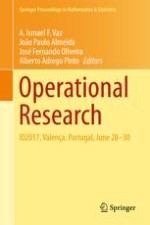This proceedings book presents selected contributions from the XVIII Congress of APDIO (the Portuguese Association of Operational Research) held in Valença on June 28–30, 2017. Prepared by leading Portuguese and international researchers in the field of operations research, it covers a wide range of complex real-world applications of operations research methods using recent theoretical techniques, in order to narrow the gap between academic research and practical applications. Of particular interest are the applications of, nonlinear and mixed-integer programming, data envelopment analysis, clustering techniques, hybrid heuristics, supply chain management, and lot sizing and job scheduling problems. In most chapters, the problems, methods and methodologies described are complemented by supporting figures, tables and algorithms.
The XVIII Congress of APDIO marked the 18th installment of the regular biannual meetings of APDIO – the Portuguese Association of Operational Research. The meetings bring together researchers, scholars and practitioners, as well as MSc and PhD students, working in the field of operations research to present and discuss their latest works. The main theme of the latest meeting was Operational Research Pro Bono. Given the breadth of topics covered, the book offers a valuable resource for all researchers, students and practitioners interested in the latest trends in this field.
